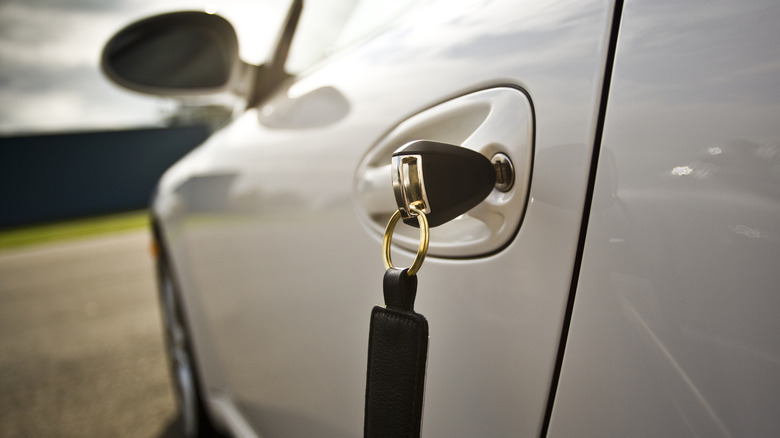Why Don't All New Cars Come With Keys Anymore?
In the old times, you wouldn't be able to go anywhere without your metal car keys. You need it not only to start the ignition, but to even get into the vehicle in the first place. These days, though, not all new cars come with such keys. In their place are electronic key fobs. These battery-powered plastic keys play a major role in modern cars' so-called keyless entry and keyless go system.
Just as its name suggests, keyless entry is your vehicle's capability to unlock itself and let you inside without the hassle of actively using a key. Keyless go functions the same way: you can run the car even when you don't insert a key into the ignition. With this keyless system, all you really have to do is approach the car with the key fob on your person and then press the small button on your car door handle to unlock it. To start the ignition, simply push the start button. All of these work because of the silent wireless communication between your car's sensors and your key fob.
Seeing as you don't need to fish for your keys from your pocket or bag every single time, the keyless system was a major convenience to owners. Besides offering ease of use, it's actually a way for car manufacturers to prevent thieves from hot-wiring vehicles. But is the keyless system all that great?
The downsides of keyless entry and keyless start
While the convenience of never having to pull out a physical car key from your pocket sounds like a dream, there are some serious drawbacks to modern cars' keyless entry and keyless start. Probably the biggest concern of all is the risk of theft. Bad actors don't have to physically steal your key fob to get into your car — they just need a transmitter and amplifier. These devices can simulate your key fob being near the vehicle even when, in reality, it's inside your home.
How this relay theft works is simple: one thief holds the transmitter close to the car, and their accomplice stands right by your doorway (where you'll likely leave your key fob) with the amplifier. The transmitter listens for your car's signal and sends it to the amplifier. Once the key fob detects this signal, it answers back. The amplifier captures this response and relays it to the transmitter, finally unlocking your car.
Another popular method among car thieves is the use of a handheld emulator. This functions just like your key fob and doesn't require an accomplice at all. The bad actor can simply walk towards your car with the emulator on hand, open the door, and go on their merry way. All the while, your vehicle thinks the emulator is an authentic key fob.
If your car has an easily accessible opening like a sunroof, it could be vulnerable to OBD port hacks too. What the OBD port does is tell you what problems your car is having to give you an idea of how to troubleshoot it. However, it's also becoming one way for thieves to delete your key fob from the system and add a new one they can then use to steal the vehicle.
How to protect your keyless car
Modern key fobs automatically sleep and deactivate the keyless system when they're left stationary in the same place for a certain period. If you're not sure whether your key fob sleeps when unmoved, it's best to just disable its wireless signal functionality altogether. This guarantees that thieves won't gain access to the radio waves. For example, with a Toyota Corolla Hatchback, you can turn off the key fob by simply pressing the unlock button twice while you're holding down the lock button at the same time. Doing so puts it in battery-saving mode, which stops it picking up the car's signal and allowing keyless entry. For Ford cars, you can switch off keyless entry from the info display. Navigate to Settings > Vehicle Settings > Locks and disable Intelligent Access (KeyFree on some models).
For vehicles with no keyless system deactivation, you can try isolating the key fob instead. Put it inside a Faraday pouch as soon as you get out of the car (nope, wrapping the fob in foil doesn't really work). What this bag does is jam electromagnetic signals, both coming in or going out. If you're skeptical, you can easily test your Faraday pouch. Stick your fob inside, go near the car (or even place the pouch right on your door), and then check whether the car automatically unlocks like it normally does. It's also a good idea to store your key fob and spare far from openings like front doors and windows to further weaken its signal to outsiders.
If you can't avoid parking outside, physical deterrents like a steering wheel lock, wheel clamp, pedal lock, or a lockable cover for the OBD port might help. A car that can cause a lot of hassle can look unattractive to bad actors, so they might just leave it be.


